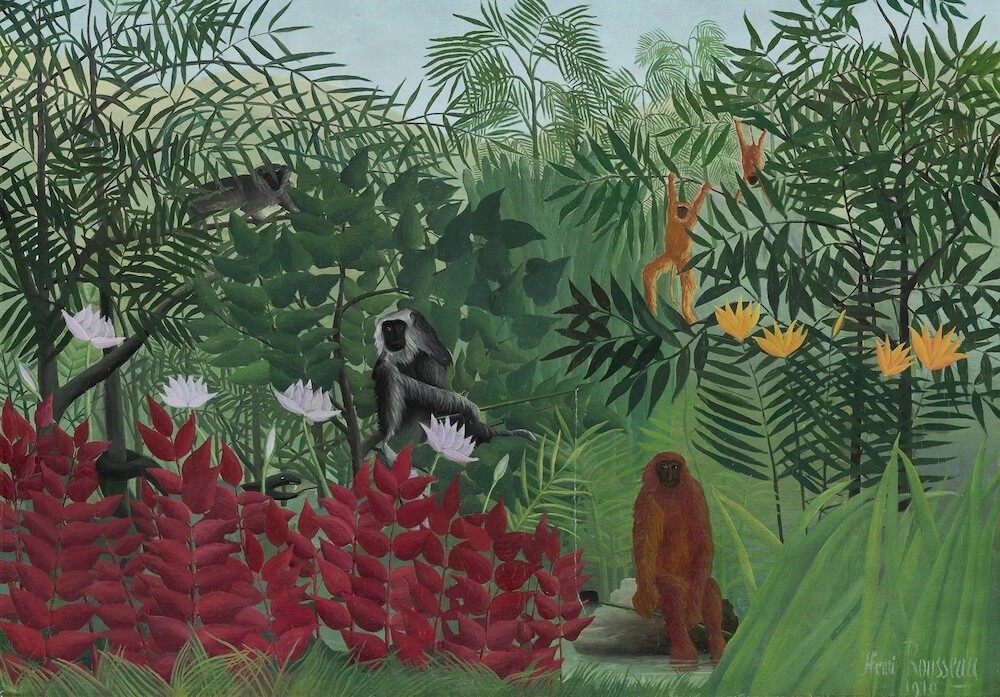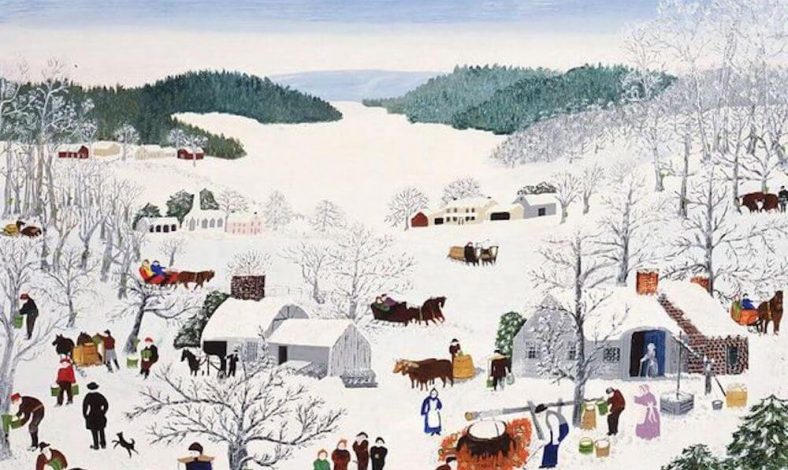Chief Editor at Nerdish
Is naive art actually art?
Who is a real painter? That’s someone who studied art in the academy or privately. Someone who probably belonged to some movement, some style: cubism, fauvism, futurism, and dozens of -isms categories. Someone who pursues his\her career through constant training, often starting in the early years. These are stories of Monet, Gauguin, Cassatt, O’Keefe, etc.
On the other hand, there are many naive painters who don’t fit into these frames. They never got special tuition nor belonged to any art group and even had a wholly different lifestyle before painting.
What is naive art?
Naive is an umbrella term for artists who don’t recognize or acknowledge conventional rules of traditional art. Naive works are easily recognized by childlike simplicity, lack of realism, flat perspective, and “floating” figures. Also, they are super-detailed and saturated with bold colors. Naive artists are not the same as amateurs or hobbyists who work for fun when they have free time. Naive painters would be full-time artists, even if they started their careers later in life. It was a case of Henri Rousseau, a French artist who first had a full-time job at custom service. He started his painting career in his early 40s and became a crucial figure in the naive art movement.

Naive art became a separate category at the beginning of the 20th century when modernists were looking for different art to get free of the traditional system. They got inspired by these unconventional artists and adopted some of their “moves,” like the flatness of perspective and vivid palette. In these terms, naive artists influenced trained ones, for example, Henri Matisse.

Naive and folk art are not the same thing. The first defines art created by a person who lacks formal education and training. The second one has a close connection to local cultural heritage. In these terms, naive art is a broader category that can incorporate folk art.
Naive works may not have this refined harmony of drawing & coloring or accurate proportions, but something makes us admire them anyway. One of the most bright figures in American naive & folk art is Anna Mary Robertson Moses. She is known as Grandma Moses in art history, a nickname she got because she was a grandma at the start of her career – 78 years old. Grandma Moses is one of the most beloved US painters who graced the cover of the December 1953 issue of TIME when she was 93.

Why did the naive art of Grandma Moses gain popularity?
Anna Mary Robertson was a country girl born in upstate New York in 1860. Growing up on the farm, she learned how to cook, grow plants and take care of animals. That’s what her life was: living and working at the farm, marrying a farmer, and giving birth to 10 children.

Her favorite hobby was sewing, which consequently influenced her art. Then, at 78, Anna Mary got arthritis, so she gave up sewing and switched to some more prominent instrument. That’s how she ended up with brushes. Moses worked with any materials at hand for her first works, from house paint and fireboard to matches and pins to paint small details. Moses explained that “painting isn’t important; the important thing is keeping busy.”
Many naive artists tend to recreate the world around them, often lyric and idealized. That’s true for Moses, who provided visual mythology about the good old past. In her interviews, she explained that she was painting memoirs of her childhood as she remembered it: farmers, animals, simple little things.

Grandma Moses gives us a glimpse into America’s pastoral past. We get picturesque documentation of rural life in the United States in the late 19th century, when farmers lived simple, down-to-earth lives, changing their activity according to seasons. One of the most famous views of Moses’ paintings is Red Checkered House. The artist painted it numerous times as a symbol of old-fashioned America.
In the first half of the XX century, the USA experienced massive industrialization and rapid growth of the cities. Life was getting faster, more expensive, and in many ways – more complicated. Moses showed people something familiar to give their minds a rest. Her good old times narrative gained special praise.
The popularity of folk art is much due to its representation of people’s values and beliefs. It has strong roots in some areas or states and helps to identify its local cultural code.

Grandma Moses’ art provides a strong sense of community when people work close to one another, helping in the best way possible. It’s about collaboration, support, and feeling that someone has your back. This powerful sense of community remains an antithesis to our modern life, when neighbors may not know each other’s names.

Moses was raised in a big family and, in later life, had nine grandchildren and over thirty great-grandchildren. Consequently, her art is strongly associated with holidays, especially Christmas and Thanksgiving. She believed that “people should take time to be happy,” and holidays were the perfect occasion. The audience admired her holiday series for the light-hearted optimism and feeling of home. In 1947 alone, Hallmark, a postcard company, sold 16 million cards with Grandma Moses paintings.

Regarding her winter works, Moses was criticized for using sprinkled glitter to paint snow, but she insisted it was the best way to recreate the snow shimmering in the sunlight. This story highlights another feature of naive art: there is no choice limitation of materials nor rules of what should or shouldn’t be on canvas.
Grandma Moses became an inspiration to many generations, thanks to her art and career. The artist never intended to popularize her craft, creating it much to her satisfaction. Moses always said that anyone could paint, even without training, when asked about her passion. If that’s the thing one wants to do, one should.
The example of Grandma Moses restates a belief that it’s never too late to start over and pursue a new path. Moreover, even someone without special training or traditional education can also succeed. This idea is especially relevant in our era when people tend to change their vocations numerous times throughout their life. And – again – it’s never too late. Grandma Moses worked till her last years, creating about 2000 works. She died in 1961, being 101 years old.

Grandma Moses made a rock-star career in a few years, despite her prior intention to create art for art’s sake. First, in 1938, an art collector Louis J. Caldor discovered her works in a pharmacy window in a tiny town of New York. A year later, Moses took part in New York’s Museum of Modern Art exhibition titled “Contemporary Unknown American Painters.” Although she was presented as “Mrs. Moses,” the press renamed her “Grandma.” Finally, the painter had her solo exhibition in Galerie St. Etienne in NYC at 80 years old.
How much does naive art cost?
By the middle of the XX century, naive art became a fully recognized phenomenon, being represented in major art galleries. For instance, Grandma Moses has been a part of regular exhibitions in MoMA New York, Art Institute of Chicago, and The Phillips Collection in Washington DC.
Speaking about the sales, naive artists usually didn’t work with managers or do advertising, at least at the beginning. Often, they worked in isolation without a community of fellow artists or collectors to create a network for selling. This was the case of Kateryna Bilokur, a Ukrainian folk artist, who lived in a small village and actually was bullied by her neighbors for making art.

While naive art pieces haven’t broken world records yet, auction bids have been steadily increasing in recent years. In 2018, a work by Georgian painter Niko Pirosmani sold for over £2 million at Sotheby’s.
That said, a work by Paul Gauguin, who was highly influenced by the naive and folk art of Tahiti, was sold for $300 million in 2015.

As for Grandma Moses, she was selling her pieces directly in her neighborhood for $3-$5 at the beginning of her career. However, when she became popular, the prices went up to $8-$10 thousand a piece. In 2006, Moses’ work Sugaring Off was sold at auction for US$1.360 million.

In one of her late interviews, she commented on her success, saying:
“I don’t advise anyone to take painting up as a business proposition unless they really have talent… But I will say that I have done remarkably for one of my years and experience.”

